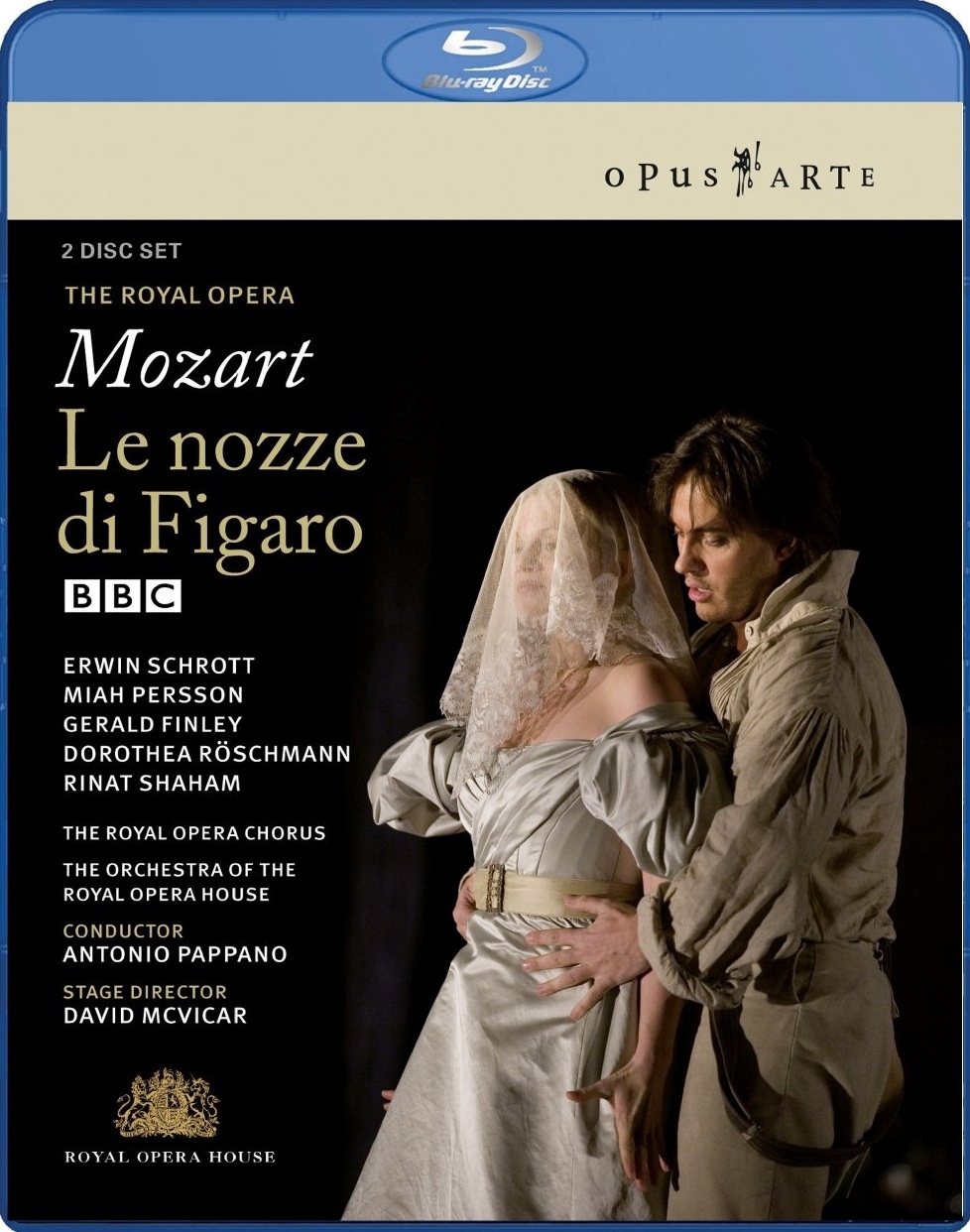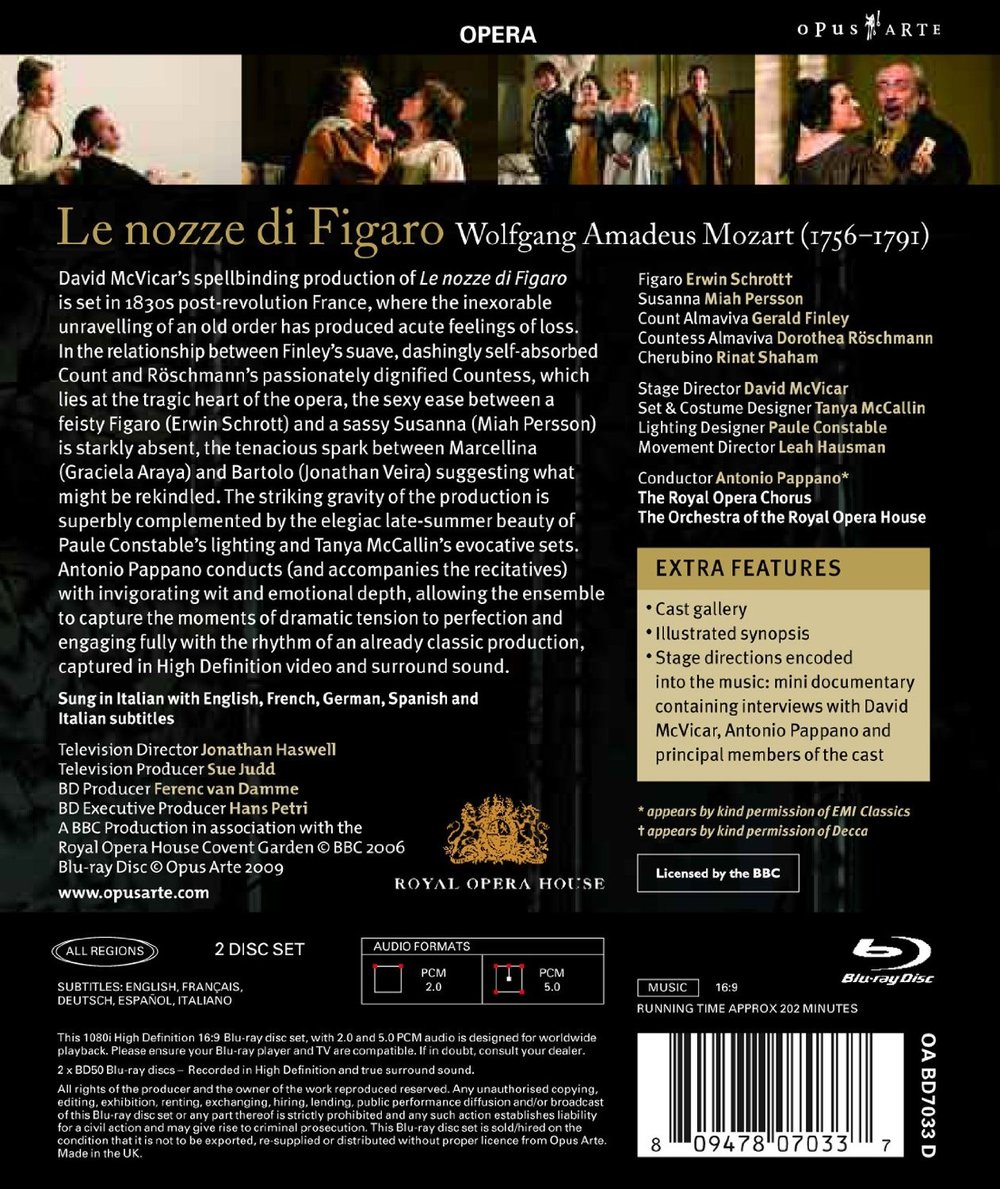

💓 Wolfgang Amadeus Mozart Le nozze di Figaro opera to libretto by Lorenza da Ponte. Directed 2006 by David McVicar at the Royal Opera House. Stars Erwin Schrott (Figaro), Miah Persson (Susanna), Gerald Finley (Count Almaviva), Dorothea Röschmann (Countess Almaviva), Rinat Shaham (Cherubino), Jonathan Veira (Dr. Bartolo), Graciela Araya (Marcellina), Ana James (Barbarina), Philip Langridge (Don Basilio), Jeremy White (Antonio), Francis Egerton (Don Curzio), Glenys Groves (First Bridesmaid), and Kate McCarney (Second Bridesmaid). Antonio Pappano conducts the Orchestra of the Royal Opera House (Associate Concert Master Sergey Levitin) and the Royal Opera Chorus (Chorus Director Renato Balsadonna). Set and costumes by Tanya McCallin; lighting by Paule Constable; movement direction by Leah Hausman. Directed for TV by Jonathan Haswell; produced for TV by Sue Judd. Released 2009, title has 5.0 PCM sound. Grade: A+
From Wonk Gordon Smith:
“This production is a gem. It shows the Royal Opera House Covent Garden at its best in all respects: superb cast, impressive staging, dramatic lighting, and spirited music making. David McVicar once again provides us with a captivating production using beautiful, cleverly designed sets that seamlessly change from one scene to the next with all the smoothness of a cinematographic cross fade.
From the very first bars of the overture, driven at a cracking pace by Antonio Pappano, we know this is going to be a winner. And it is particularly refreshing to have a lot of carefully choreographed stage business going on during the overture instead of staring blankly at closed curtains. This means that by the time we meet Figaro (Erwin Schrott) and the pert, sassy Susanna (Miah Persson), we have already settled comfortably into the palace of Count Almaviva and the below-stairs environment in which this timeless story is played out.
The casting is first class in every respect. They are all glorious singers and wonderful actors, with the rich voice of Gerald Finley and the liquid, warm tones of his countess wife (Dorothea Röschmann) standing out. But the real star of the show is Miah Persson, who manages to be delightfully feisty and tenderly disarming all at once. Cherubino (Rinat Shaham) also deserves special mention, playing her ambivalent "trouser" role to perfection with tousled hair and a cheeky, boyish grin that makes him (her) instantly likeable.
There are a couple of quirks that may make you wonder why such choices were made. The first of these was the decision to transport the story from its usual setting in Seville to post revolutionary France. Apart from being an excuse to present some very fine costumes, we may wonder how the Count—and his wife—managed to dodge the guillotine and why his decision to forego a nobleman's rights to sleep with the servants should be such big news. The second is the rather curious "indoors outdoors" garden scene setting when uncharacteristically symbolic, silhouetted leaves are lowered in front of the palace windows. But none of this matters as we are all swept along by the music, the acting, and the singing.
This production is also very well served from a technical point of view with razor sharp images, three-dimensional depth magnificently sculpted by the lighting, and excellent, totally believable sound. It is also satisfying to see a growing number of long shots treating us to a view of the whole stage. Thanks to the high-definition images, we are then able to see everyone in proportion to the set without missing any details. This increases even further the illusion that we are actually there, in the Royal Opera House, sitting in our plush seats with the red and gold auditorium gleaming and glowing all around us.”
Further comments from Wonk Henry McFadyen. To grasp what a supernova event Le nozze di Figaro was in the history of music, first watch the Gluck Orfeo ed Eurydice title shot at the Český Krumlov Castle staring Bejun Mehta as Orfeo. It's a short, pleasant piece from a bygone era with 3 named stock characters and a single plot idea. Mozart produced Le nozze di Figaro 24 years later: it lasts 3+ hours and has 11 well-developed, believable named characters involved in several intricate plot themes full of fast-breaking events. It's an hilarious situation comedy with serious comments that are pertinent today. The beauty and intensity of the music never lags. The straight-forward (if complicated) story telling in Le nozze has been the basic model for opera ever since. But with so much packed into this work, you have to hang on tight lest you slip and fall under the wheels.
Here are a few screen shots introducing the main characters and the basic plot themes. This is the story of the efforts of Figaro (Erwin Schrott) on his wedding day to actually marry his sweetheart Susanna (Miah Persson). Figaro and Susanna are both servants in the household of Count Almaviva (Gerald Finley), and here we see them in a storage room that the Count has made available to them for living quarters. It's early morning; Figaro and Susanna have no inkling how hectic the rest of the day will be:
There remain several impediments to the marriage. Figaro borrowed money from Marcellina (Graciela Araya) and signed a contract to marry her if he doesn't pay off the debt, which is still due. Marcellina figures that if Figaro is going to marry at all, it has to be to her. Here Marcellina and Susanna, both commoners, engage in a savage battle to see who can extend the most noble and courteous compliment to the other:
Marcellina works as housekeeper (H'mm) for Dr. Bartolo, who has a personal grudge against Figaro:
But the biggest impediment for Figaro is Count Almaviva. Although married to the beautiful and gracious Countess Almaviva (Dorothea Röschmann), he is a serial philanderer. He now lusts for Susanna, and he hopes to somehow prevent her from marrying Figaro:
Here we see the Count with Susanna and the music teacher, Don Basilio:
Finally, we meet the long-suffering Countess, who laments the infidelity of her husband:
Mozart included a trouser role, Cherubino (Rinat Shaham), a page. His youthful beauty has bewitched all the women in the palace and infuriated the Count, who demands to be the only rooster in the barn:
Mozart probably delighted in having this scene of a woman playing a male who gets dressed as a girl. The idea was to trick the Count into making a date with Suzanna one evening in the garden. The ladies planned to send Cherubino instead of Susanna to the tryst. They then hoped to observe the Count in his attempted infidelity and later teach him a lesson:
But after too many misadventures with the women of the palace, Almaviva gives Cherubino an officer's commission in the Army. Mozart writes some military music and Figaro explains how lucky Cherubino is to allowed to bear arms:
As the action picks up momentum and complexity, we get lines like the next 3 screenshots:
All leading to this scene, which you can probably see again any day now if you just watch a few soap operas:
So far the Count has failed to stop Figaro's marriage. But he is pleasantly surprised as Marcellina comes forward to demand that she, and not Suzanna, should marry Figaro:
And this leads to the famous finale to Act 2 just before the intermission (interval):
I'm not going to explain the outcome of Marcellina's lawsuit. It's afternoon now; and in a heart-wrenching scene, the poor peasant girls give Susanna their wedding presents of wild flowers:
Cherubino is absent without leave from the Army and is hiding dressed as a peasant girl. When he's found out, the peasant girl Barbarina solves Almaviva's Cherubino problem with a deal he can't refuse:
"That I could have anything I wanted. So ..."
It's autumn and the sun goes down early. There's still time now to stage the tryst (proposed earlier) in the garden between the Count and Susanna. The invitation is snapped up by the Count. This leads to Act IV with a series of remarkable arias about life and love. After swapping clothes with the Countess, Susanna sings her famous love song, "Deh vieni," which director David McVicar calls (in the keepcase notes) the climax of the opera:
After other complications in the plot, the Count finally approaches his wife dressed as Susanna:
Caught in a video gone viral on You-Tube, the Count is mortified and neutralized. After begging for and receiving forgiveness from the Countess, all the other women in the palace are finally safe. Figaro can get married:
After the grand finale below (with all 11 named characters lined up in a rank), there will be a triple wedding. Can you guess who the 3rd couple will be?
We hope this review will inspire you to experience this wonderful work and recording for yourself. It is a good candidate to be called the best video of Le nozze di Figaro ever made and maybe even the best opera video ever made.
Here are two clips from this show---couldn't find one of Persson as Susanna:
OR


























